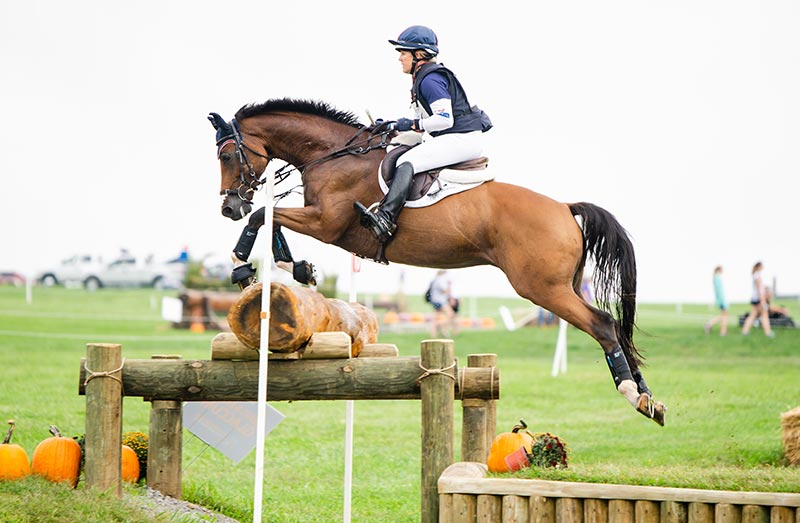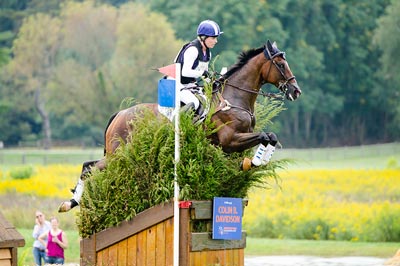
by Laura Crump Anderson, an Equestrian Fitness Specialist at InForm Fitness Leesburg. She is certified as a personal trainer by the American College of Sports Medicine and specializes in working with riders of all ages and disciplines. Read more of her EN fitness columns here.
For the equestrian, I have yet to find the silver bullet or formula that computes the exact fitness required of everyone. I have concepts, frame works, guidelines, but just like horses, human athletes have variables that impact their performance. An Advanced horse and a Beginner Novice horse do not require the same level of fitness. In fact, bringing a horse down from the upper levels can be just as challenging as moving up. Warmbloods typically require additional conditioning to reach peak fitness, compared to their Thoroughbred counterparts. Add imbalance or injury into the mix and you have enough variables for a scientist to struggle to approve anything as statistically significant.

Technical
My advice for the amateur:
The best way to improve our riding is time spent in the tack, and sitting on as many different horses as possible, because they will all teach you something. Listen to your instructor’s guidance and do not pass up the opportunity for a switch ride when they present themselves. For the experienced rider, can learn steadily from a schoolmaster, as they can a green horse. We exercise outside of the tack to improve so that we are not struggling with our own fitness while on the horse.
My advice for the professional:
Start your day with the most technical ride. This does not mean ride the most challenging horse first every time. Rather, when you are freshest physically and mentally, pick a specific and technical ride of the day. Typically, this tends to be a flat ride. Riding the same horses in the same order every day is one of the pitfalls professionals can fall into as we are creatures of habit.
Whenever possible save the conditioning rides for last, as these require the least amount of technicality, but are just as important for your conditioning as for the horses. While you do not need to do every conditioning ride; you are doing yourself a disservice to always pass these rides on to working students. That said, do not forget the importance of rest and recovery.
So why exercise?
While exercise does not improve one’s technical ability, we exercise to gain muscle for optimal movement, energy, and protection from injury. Our skeletal muscles serve as the engine, support structures, and shock absorbers of our bodies.

Strength Training
Strength training is an essential piece of rider fitness because it provides the most bang for the buck (in this case, the amount of time) when it comes to fitness. Strength training builds muscle that prevents injury, improves core strength and stability, boosts the metabolism, and increases energy and endurance. Putting muscle on our bodies is the best way to prevent the natural atrophy that occurs with age and will help us achieve our goals as riders.
I have heard people say that they do not need to strength train because the horses they ride are light in the bridle and contact. This is a misunderstanding of the benefits from strength training. Riders should not expect to become stronger in their aids, but quite the opposite. Strength training allows a rider to fine tune their aids, because they can maintain their form. The biggest impact that I have seen and felt from strength training is improvements in the sitting trot.
Off the horse riders develop improved control of their essential core muscles (without interference from the horse’s movement). This leads to an improved ability to correctly apply aids in the tack, because the horse is not trying to decode the white noise that comes from a weak seat. Strength training also has a beneficial impact on one’s galloping position, much more so than running or getting on an exercise bike. All eventers should regularly take lessons with a professional and make sure their stirrups are the correct length. Posting in the gallop is detrimental to a horse’s wellbeing. However, it is frequently associated with a rider who lacks the strength to maintain the position and is much more rarely an endurance fatigue.
Eventers should be strength training AT LEAST once a week. (This does not have to be done in a gym, but KNOW that water buckets and wheelbarrows do not count as strength training.)
Flexibility
When you are bringing a horse back into work, you want to progress slowly and do so as balanced as possible. To achieve this, we must work on our own flexibility and balance off the horse. This is an essential piece of the puzzle!
Yoga classes are a great way to identify where our own imbalances lie. Note that standing on one foot will help you notice imbalance in your own body from left to right but will not actually improve your balance on your horse. The improved balance develops from time spent in the tack. Some yoga classes have an incredible level of intensity, just make sure that these classes do not interfere with the equally essential piece of the puzzle — rest and recovery.
If you are ever presented with the opportunity to take a Yin Class, jump on it. In this style of yoga, you will quickly identify the parts of your body that require the most flexibility work. Many event riders tend to have very tight hamstrings and lower backs. However, all equestrians can benefit from stretching the inner thigh. Two great asanas or poses for this area of the body are the frog pose or wide-leg wall stretch. Eventers should be doing 7-10 minutes of flexibility work each day.
Aerobic Capacity
One of the greatest challenges inherent in our sport is that as we move up the levels, the increase in demand for the horse’s fitness leads to increased conditioning work for the rider. The best way to get fit for riding is in the tack. When figuring out if you have sufficient aerobic capacity, consider how are you feeling when you finish. If you are coming off the cross country course tired but you can catch your breath, you are doing great. If you are coming off the course winded, you may want to think about looking into doing some VO2max testing. Galloping is typically done at about 80%-85% of a rider’s VO2max, so you should be able to maintain this for the length of time of cross country.
However, do not just assume you are doing enough. Instead, track and time your fitness rides, as they are just as important for you as they are for the horse. Notice your breathing. It is not uncommon for amateurs and professionals to hold their breath while riding. Working on focused breath work outside of the tack, will help with holding the breath on course.

The Problem with Traditional Cardio
I know many professional athletes, who have done more damage to their bodies pounding the pavement running than they did taking a tumble or two off a horse. If you love running, great. RUN. I get it. I love riding my horse and understand that many individuals feel just as passionate about their running programs as I do riding. To ask them to stop running is tantamount to asking me to stop riding! However, when your body is speaking to you (with shin splints, knee pain, hip pain), it is time to stop running, unless running is more important to you than your riding. Most importantly, DO NOT RUN FOR THE SAKE OF GETTING FIT FOR YOUR HORSE.
Rest and Recovery
THIS IS A PRIORITY NOT AN OPTION.
Rest and recovery is an essential piece of the equation that is often over looked in a fitness routine. To improve strength, rest and recovery are just as important as applying a stimulus to build muscle. Striving to get eight hours of sleep each night has a huge impact on performance.
Your body also requires a day off once a week to rebuild and repair. You would not ride a horse for a month straight, so why are we doing this to ourselves? You are a valuable asset, so please treat your body to the rest it not only deserves, but also needs.
This article originally appeared on EventingNation.com and is pubilished here with permission/
Find out more about Clinicians and Trainers and Eventing here on EIE.


































